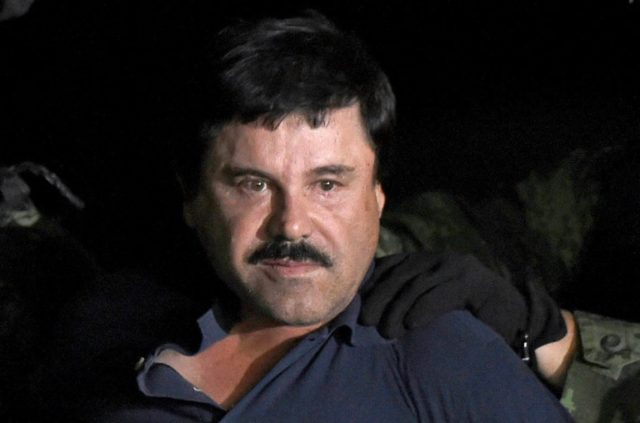New York (AFP) – Mexican mobster Joaquin “El Chapo” Guzman was convicted Tuesday of crimes spanning a quarter-century in a trial that laid bare his lavish lifestyle and penchant for extreme violence as head of one of the world’s most powerful gangs.
The 61-year-old former boss of the notorious Sinaloa cartel — famed for his brazen escapes from Mexican prisons — faces life in prison for smuggling tons of cocaine, heroin, methamphetamine and marijuana into the United States.
He was also found guilty on money laundering and weapons possession charges during a three-month trial in which witnesses described the mob boss beating, shooting and even burying alive those who got in his way.
“The verdict was a tremendous victory for the rule of law, for Mexico, the United States and other countries that have been victims of the Sinaloa cartel,” Mike Vigil, former head of international operations for the US Drug Enforcement Administration, told AFP.
“Chapo Guzman was the world’s greatest drug lord of all time,” Vigil added. “He surpassed other drug lords, including Pablo Escobar.”
In a three-month trial that unfolded like a real-life telenovela, Guzman’s ex-henchmen and a former mistress took the stand under the gaze of the stocky gangster, whose nickname is Spanish slang for “shorty.”
His young wife, onetime beauty queen Emma Coronel, showed up almost every day in court to be with her husband.
After sentencing on June 25, Guzman is likely to be transferred to a so-called “supermax” prison in Colorado, sometimes called the “Alcatraz of the Rockies” and considered one of the most secure in the US.
His conviction is seen as a big win for the US, which failed to obtain the extradition of Escobar, the Colombian drug lord who was killed in a police operation in 1993.
Guzman’s lawyer Bill Purpura said his client had expected the verdict but was a “guy who never gives up” and had vowed to appeal.
– Ultra violence –
During the trial, the government presented 56 witnesses and troves of incriminating material, including intercepted calls between Guzman and his associates, and conservations taped secretly by informants.
Some of the most eye-watering testimony came from a former hitman who offered gruesome details about acts of torture and killings of rivals personally carried out by his then boss.
Isaias Valdez Rios told the court he saw Guzman leave one captive — a rival from the Arellano Felix cartel — in a chicken coop for two days After two interrogations, Guzman shot the man — before ordering him buried alive.
On another occasion, the court heard, Guzman beat two members of the Zetas cartel with a thick tree branch till their bones were broken before shooting them dead.
Guzman was not on trial for murder, but federal prosecutors attempted to depict him as a violent and ruthless man, ready to do anything to protect his business.
Former employees testified that the cartel paid bribes of millions of dollars at the highest levels of government, including to former President Enrique Pena Nieto, who denies the allegation.
The trial also offered a glimpse at the opulent lifestyle led by Guzman, who grew up in poverty.
His ex-pilot and former cartel manager for Mexico City testified that Guzman had four airplanes, numerous houses including a mansion in Acapulco, a yacht named “Chapito” and a ranch that included a zoo and a small railway.
– ‘Garbage’ testimony –
In his closing arguments late last month, another of Guzman’s lawyers, Jeffrey Lichtman, asked the jury not to convict on the basis of the “garbage” testimony of government witnesses.
Lichtman contended that Guzman was merely a “scapegoat,” and that the real culprit in the drug trafficking operations was Ismael “El Mayo” Zambada, the co-founder of the Sinaloa cartel.
“Mayo has been the largest narcotrafficker for decades in Mexico. He has never been arrested. He has paid hundreds of millions of dollars to stay free,” Lichtman said.
The government, meanwhile, appealed to the jury not to let Guzman “escape” — an allusion to his two spectacular jail breaks in Mexico, the last in 2015 through a tunnel from a shower area in his cell.
The defense called just one witness, an FBI agent put on the stand in an attempt to undermine the credibility of one of Guzman’s cocaine suppliers who had testified against him.
The defense’s strategy centered on attacking the credibility of the cooperating witnesses — former secretaries, pilots, cocaine suppliers, Guzman’s top trafficker in the United States, a manager, an accountant, a former communications chief, and a former lover.
Most are serving prison sentences and hoped to have their penalties reduced in return for their cooperation with prosecutors.

COMMENTS
Please let us know if you're having issues with commenting.